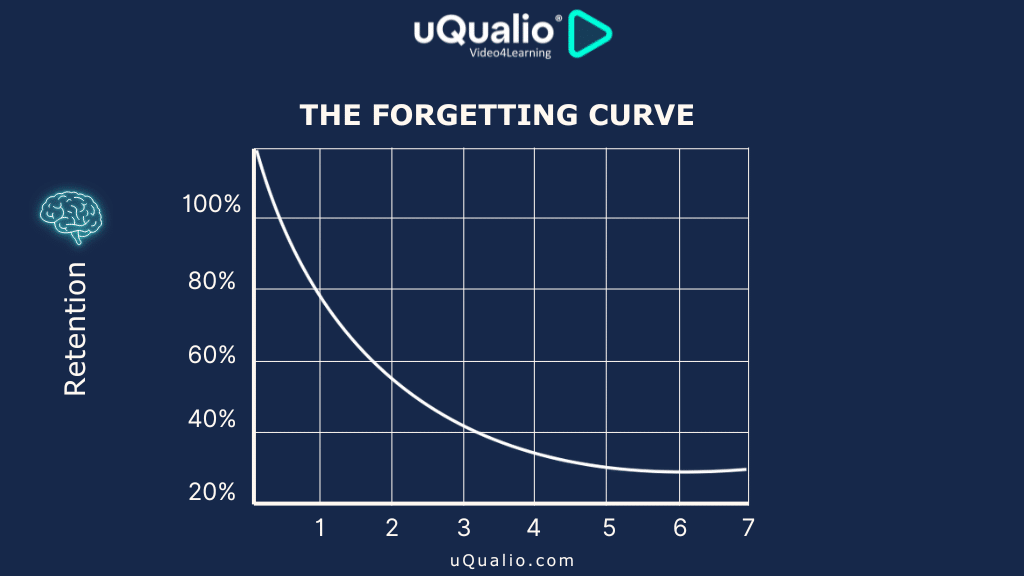Ever crammed for a test only to forget everything the next day? It’s due to the forgetting curve, a concept by psychologist Hermann Ebbinghaus, which shows that we forget up to 70% of new information within 24 hours.
The Forgetting Curve and Learning & Development (L&D)
Long training sessions often fall victim to the forgetting curve, leading to lost knowledge and costly inefficiencies for businesses. uQualio’s video4Learning platform addresses this issue using Ebbinghaus’ principles.
How uQualio Tackles the Forgetting Curve
- Microlearning: Short video lessons (1-10 minutes) reduce cognitive overload and improve retention by up to 50%.
- Spaced Repetition: Intelligent algorithms schedule reviews at optimal intervals, boosting long-term retention by up to 250%.
- Engagement Through Video: Video-based learning keeps viewers engaged and improves retention by up to 65% compared to text.

The Benefits of uQualio’s Approach
uQualio’s video4Learning platform uses these methods to combat the forgetting curve, ensuring your team retains knowledge and skills.
Ready to Learn More?
Contact uQualio to discover how microlearning and spaced repetition can revolutionize your corporate training.
Explore related blog posts on our site to learn more about optimizing your learning and development strategies.
Hermann Ebbinghaus (1850-1909) was a pioneering German psychologist who made significant contributions to the scientific study of memory. He is well-known for being one of the first to study memory through experiments rather than just philosophical thought. His work laid the foundation for much of what we know about how memory works today.
Ebbinghaus’s Research on Memory
Ebbinghaus is most famous for his research on the forgetting curve and the spacing effect. He conducted meticulous experiments on himself, using nonsense syllables to ensure he was studying pure memory processes without prior associations.
Key Findings
The Forgetting Curve:
- What it is: The forgetting curve shows how quickly we lose information after learning it. Most information is forgotten rapidly within the first few days, and the rate of forgetting then slows down.
- Details: Ebbinghaus found that within the first hour of learning, about 50% of information is forgotten. This increases to around 70% within 24 hours.
The Spacing Effect:
- What it is: The spacing effect shows that information is more effectively remembered when study sessions are spaced out over time rather than crammed into a short period.
- Details: Ebbinghaus found that spreading out study sessions over time leads to better long-term retention compared to trying to learn all the material in a single session.
Impact on Learning and Development
Ebbinghaus’s findings are crucial for improving learning and development strategies. Traditional long training sessions often result in rapid forgetting, making it difficult for employees to retain and apply new knowledge effectively.
Strengthening Memory
Ebbinghaus also identified factors that influence how well we remember information:
The Strength of the Memory:
- Explanation: Stronger memories last longer. In corporate training, the content should be highly relevant and meaningful to each learner to create strong, lasting memories.
Time Since Learning:
- Explanation: The forgetting curve shows that without reinforcement, learners forget an average of 90% of what they learned within the first month. This highlights the need for continuous learning and regular reinforcement.
Education 5.0 Technology can help beat the Ebbinghaus Curve
To combat students forgetting there are some technology strategies you can use to combat the Forgetting Curve:
Microlearning:
- Concept: Breaking down information into small, easily digestible chunks or bites.
- Benefit: This approach reduces cognitive overload and aligns with the brain’s natural learning process, improving retention.
Spaced Repetition:
- Concept: Reviewing information at increasing intervals.
- Benefit: This method combats the forgetting curve and significantly enhances long-term retention.
Engagement Through Multimodal Learning with Video
- Concept: Using videos to deliver learning materials.
- Benefit: Videos engage multiple senses and can maintain attention better than text-based learning improving memory retention.
Ready to transform your training? uQualio’s video-based platform ıs all about this and can can enhance learning in your organization. Start a free trial or book a demo now!
Achieve Effective & Affordable Video Training
– uQualio is an award-winning, easy-to-use, all-in-one NextGen LMS software for any types of online video training.












